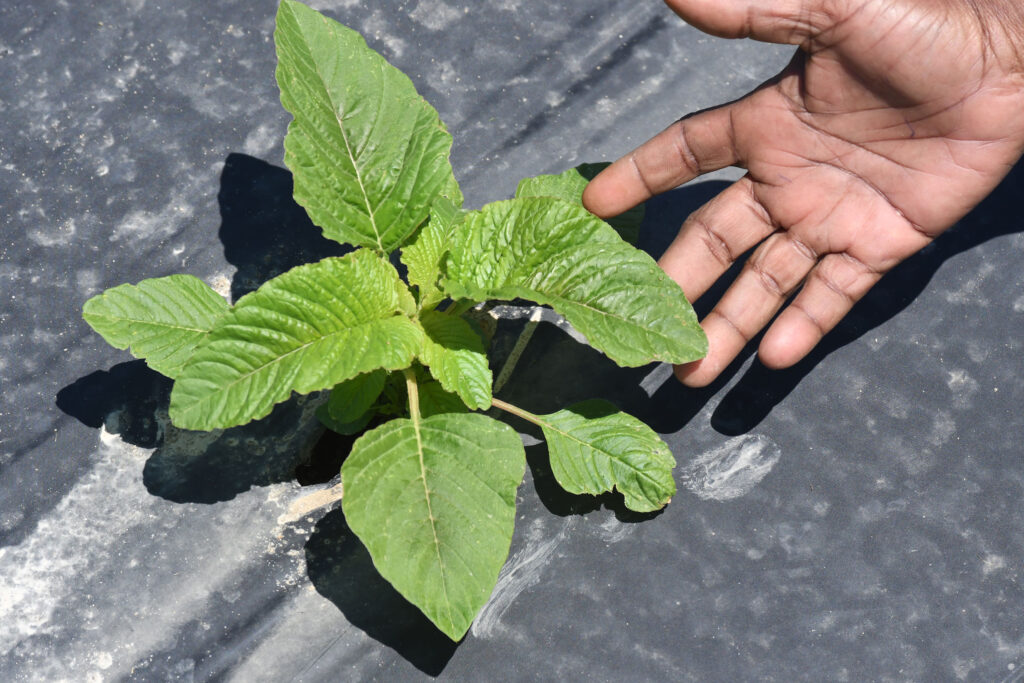
In spring 2022, the Maryland Food Bank’s director of nutrition, Kate Long, presented UMES Extension’s alternative crop specialist with a proposal; assist farmers in cultivating non-native crops to supply two food pantries on Maryland’s Eastern Shore. The growers would be compensated helping to diversify their farm, while filling a growing demand for vegetables that a changing population prefer. A needs assessment showing this trend was the catalyst for Long’s request.
Dr. Nadine Burton, (left) a native of Jamaica, understood the need as an extension specialist working with small-scale farmers and on a personal level.
“I know what it feels like when I want Jamaican callaloo and can’t find it,” she said. “I know what it feels like to want scotch bonnet and settle for habanero.”
In the program’s first year, Burton said she and five collaborating farmers sold the food bank nearly 20,000 pounds of fresh produce. The need has only grown; last year, they sold nearly 100,000 pounds.
“There’s a need, an economic opportunity to grow these crops,” Burton said. “Twenty-five percent of the population on the East Coast is comprised of newcomers to the U.S. These diverse cultural groups eat different foods [that are not typically available at the supermarket].”
UMES Extension holds regular workshops and learning opportunities for farmers, putting the extension specialist in the perfect position to rally local producers to grow and sell alternative crops, opening a new revenue stream. Burton noticed, however, farmers’ interest was piqued during the workshops, but rarely did any follow through with growing or marketing the crops despite the potential financial boost to their agribusinesses.
“This year, we tried something different,” she said. “We’re turning our education into action.”
Burton recruited a group of 15 producers, mostly beginning farmers, and worked closely with them throughout the 2024 growing season. In addition to regularly held classes, Burton visited their farms offering her expertise and hands-on support. She fielded phone calls from her students almost daily.
Burton trained each farmer on what to grow, how to grow it and how to get the crops successfully to market.
Eleven of the original 15 participants completed the class. They have collectively sold more than 10,000 pounds of produce.
John Roduik, owner of Poppa Said Maybe Farm in Somerset County, Maryland, and program participant, said he cultivated 80-100 pounds of jute, callaloo and scotch bonnet each week. He observed that local wildlife didn’t eat the crops because they did not recognize them; an added benefit.
Participant Eugene Yarboro owns Harvest2Health Organic Farming in Easton and Upper Marlboro, Maryland. He said since he began growing alternative crops, including African eggplant, he strategically established relationships with restaurants creating African dishes in the Washington Metropolitan area. Those businesses are now part of his client base. Yarboro also said he qualified for more grant funding than before.
“It was a great learning experience for me,” he said.
Participant Kimberly Raikes, CEO of Edible Farms Consultants Connect in Baltimore, said since growing scotch bonnet, African eggplant and hibiscus, she’s been asked to participate in different cultural pop-ups and municipal markets.
Burton plans to welcome a new class of farmers in early 2025 with more boots-on-the-ground instruction; the previous class of students will serve as mentors.

“We know we’re going to do even better,” she said.
It was an extremely dry year in 2024. Some alternative crops, such as callaloo or amaranth, grow well with little water, unlike more traditional greens like collards and kale. Having these crops more widely available during times of extreme weather conditions would maintain a continuous stream of fresh food supply, she explained.
Alternative crops are also high-value. As communities become more diverse, the demand for alternative crops would continue to increase. This creates a niche market that sets small farmers apart from commercial growers and increases their income potential.
“I want to ensure that all the farmers we work with are functioning as an economically viable business,” Burton said.
The IFARMS2 grant and a sub-award with the Nature Conservancy.
Kara Nuzback, communication & outreach specialist, Ag Communications, UMES Extension, kanuzback@umes.edu.
Photos by Todd Dudek, agricultural communications, University of Maryland Eastern Shore, School of Agricultural and Natural Sciences, UMES Extension, tdudek@umes.edu.

